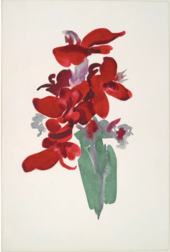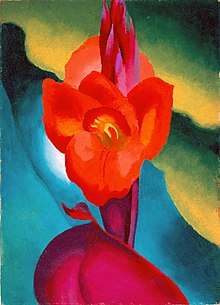Red Canna (paintings)
Georgia O'Keeffe made a number of Red Canna paintings of the canna lily plant, first in watercolor, such as a red canna flower bouquet painted in 1915, but primarily abstract paintings of close-up images in oil. O'Keeffe said that she made the paintings to reflect the way she herself saw flowers, although others have called her depictions erotic, and compared them to female genitalia. O'Keeffe said they had misconstrued her intentions for doing her flower paintings: "Well – I made you take time to look at what I saw and when you took time to really notice my flower you hung all your own associations with flowers on my flower and you write about my flower as if I think and see what you think and see of the flower – and I don't."[1]
| Red Canna | |
|---|---|
_by_Georgia_O'Keeffe.jpg) | |
| Artist | Georgia O'Keeffe |
| Year | 1924 |
| Medium | Oil |
| Dimensions | 73.7 cm × 45.7 cm (29.0 in × 18.0 in) |
O'Keeffe was not unaware of the sexual references in her work, but male art critics' misinterpretations of these references perpetuated a sexual understanding of her work that was very different from her original intention.[2] She expressed herself through the use of vibrant colors like red, yellow, and orange.
Overview
A gardener, O'Keeffe was often inspired to make a dozen or more paintings of a specific flower.[3] She became interested in brilliant colors and billowy petals of the canna lilies when she visited Lake George, New York in 1918 with Alfred Stieglitz.[4] The Pennsylvania Academy of the Fine Arts states that "In these extreme close-ups she established a new kind of modern still life with no references to atmospheric effects or realistic details, reflecting her statement, 'I paint because color is significant.'"[3]
As she evolved as an artist, her works became suggestive of female form, like Inside Red Canna. Paul Rosenfeld, who owned one of her Red Canna paintings, said "... there is no stroke laid by her brush, whatever it is she may paint, that is not curiously, arrestingly female in quality. Essence of very womanhood permeates her pictures."[5]
Red Canna (1915) watercolor

In 1915, O'Keeffe painted a watercolor of a bouquet of red canna blossoms on paper. The work, 19 3⁄8 by 13 inches (49.2 cm × 33.0 cm), is among the collection of the Yale University Art Gallery.[6]
Small Red Canna (1919)
A small painting of a close-up of a red canna lily was made by O'Keefe in 1919. The 8 in × 6 in (20.3 cm × 15.2 cm) oil painting depicts the flower against a dark cloudy background. Owned by a private collector, it is on extended loan to the Georgia O'Keeffe Museum.[7] It was stolen from the Santa Fe, New Mexico museum by a security guard, William Crumpton, who pleaded guilty on October 26, 2004 to stealing paintings and cash from the museum and a government office. The painting, valued at equivalent to $676,797 in 2019, was recovered.[8]
Red Canna (1919)

Painted in oil on a 13 in × 9 1⁄2 in (33.0 cm × 24.1 cm) board, the red canna lily framed by green and dark yellow background colors at the top and right of the painting and dark blue at the bottom and left.[9] The carefully blended colors and voluptuous curves reflect her emerging personal style.[4] Once owned by Pollitzer family members of North Carolina,[9] it was displayed at Columbia College in South Carolina, where O'Keeffe was an instructor.[10] The painting was acquired by High Museum of Art of Atlanta by 2015.[9][10]
Inside Red Canna (1919)
She painted an extreme close-up of the canna lily entitled Inside the Red Canna in 1919.[11] It is an erotic depiction of the large petals of the exterior of the flower, with focus on the interior through the use of contrasting shades of colors. The painting was made with red, orange, brown, and pink paint.[12] The 22 in × 17 in (56 cm × 43 cm) abstract oil painting is owned by private collectors.[13]
reds swelling from whites to pinks soft velvet reds
bleed into liquid rubies teasing like a swirling
skirt softly blowing in the
breeze—morning sunlight looking
through the vibrant blood
of life awakening the
morning light sun parting
—Image to Word: Art and Creative Writing[14]
Red Canna (1923)
The version made in 1923 is an oil painting of a red canna lily against a yellow background. The Lily nearly fills the 12 in × 10 in (30 cm × 25 cm) canvas. It is owned by the Pennsylvania Academy of the Fine Arts in Philadelphia, Pennsylvania.[15]
Red Canna (1924)
| External images | |
|---|---|
Pennsylvania Academy of the Fine Arts | |
Amon Carter Museum of American Art |
The 1924 painting, a close-up of the flower with streaks of light blue and gray,[16] immerses the viewer in the blossom, and is meant to convey the way that O'Keeffe experiences it.[17]
In the 1920s it was believed to be among the collection of Flora Stieglitz Strauss and possibly that of O'Keeffe in 1953. It was in private collections until 1993, when it was acquired by Sotheby's in New York. It was last recorded to be in the private collection of A. Alfred Taubman.[16]
Red Canna (1925–1926)
She painted the interior of the flower in reds, oranges, yellows, and pinks. Painted in oil, the abstract painting is 36 by 30 inches (91 cm × 76 cm). It is owned by the University of Arizona Museum of Art.[18]
Red and Orange Canna (1926)
Another close-up painted in oil, the 20 in × 16 in (51 cm × 41 cm) painting is among the collection of the Georgia O'Keeffe Museum.[19][20]
Red Canna (1927)
In 1927, O'Keeffe made a painting of a close-up of the wide red petals of the canna lily. Painted in oil, it is 36 1⁄8 by 30 1⁄8 inches (91.8 cm × 76.5 cm). Once among private collections, it is now owned by Amon Carter Museum of American Art in Fort Worth, Texas.[21]
References
- Claxton, Mae Miller (Spring 2003). "'Untamable Texts': The Art of Georgia O'Keefe and Eudora Welty". Mississippi Quarterly: The Journal of Southern Cultures: 315–30 – via EBSCO Host.
- Chave, A.C. (Winter 1990). "O'Keeffe and the Masculine Gaze". Art in America. 78: 114 – via EBSCOhost.
- "Red Canna". Pennsylvania Academy of the Fine Arts. Retrieved January 13, 2017.
- "Red Canna". High Museum of Art. Retrieved January 13, 2017.
- Marcia Brennan (August 2002). Painting Gender, Constructing Theory: The Alfred Stieglitz Circle and American Formalist Aesthetics. MIT Press. pp. 3, 86. ISBN 978-0-262-52336-3.
- "Artist: Georgia O'Keeffe, American, 1887–1986 Red Canna". The Yale University Art Gallery. Retrieved January 13, 2017.
- "Red Canna, (painting) – 1919, extended loan to Georgia O'Keeffe Museum". Smithsonian Institution Research Information System (SIRIS). Retrieved January 13, 2017.
- Steve Barnes (October 29, 2004). "National Briefing: Southwest: New Mexico: Ex-Guard Admits O'Keeffe Theft". The New York Times. Retrieved January 13, 2017.
- "Red Canna, (painting) – 1919". Smithsonian Institution Research Information System (SIRIS). Retrieved January 13, 2017.
- Mary Eloise H. Leake (December 13, 2015). "100 years ago, Georgia O'Keeffe came to the South and was forever changed". The Anniston Star. Anniston, Alabama. Retrieved January 13, 2017.
- Barbara Buhler Lynes; Jonathan Weinberg; Georgia O'Keeffe Museum (9 March 2011). Shared Intelligence: American Painting and the Photograph. Univ of California Press. p. 92. ISBN 978-0-520-26906-4.
- Marcia Brennan (August 2002). Painting Gender, Constructing Theory: The Alfred Stieglitz Circle and American Formalist Aesthetics. MIT Press. p. 7. ISBN 978-0-262-52336-3.
- "Inside Red Canna, (painting) – 1919". Smithsonian Institution Research Information System (SIRIS). Retrieved January 13, 2017.
- Kathleen Walsh-Piper (2002). Image to Word: Art and Creative Writing. Scarecrow Press. pp. 28–29. ISBN 978-0-8108-4307-3.
- "Red Canna, (painting) – 1923". Smithsonian Institution Research Information System (SIRIS). Retrieved January 13, 2017.
- "Red Canna, (painting) – 1924". Smithsonian Institution Research Information System (SIRIS). Retrieved January 13, 2017.
- David Taffet (November 19, 1999). "Still Life Resurrection". Dallas Voice. Dallas, Texas. Retrieved January 13, 2017 – via UNT Digital Library, The University of North Texas Libraries.
- "Red Canna, (painting) – 1925/1926". Smithsonian Institution Research Information System (SIRIS). Retrieved January 13, 2017.
- "Red Canna, (painting) – 1926". Smithsonian Institution Research Information System (SIRIS). Retrieved January 13, 2017.
- "About the University of Arizona Museum of Art". University of Arizona Museum of Art. Retrieved January 13, 2017.
The wide-ranging collection boasts over 6,000 paintings, sculptures, prints, and drawings. Highlights include the Altarpiece of Ciudad Rodrigo, The Visitation by the Master of the Catholic Kings, Jackson Pollock's Number 20, Mark Rothko's Green on Blue (Earth-Green and White), and Red Canna by Georgia O'Keeffe.
- "Red Canna, (painting) – 1927". Smithsonian Institution Research Information System (SIRIS). Retrieved January 13, 2017.